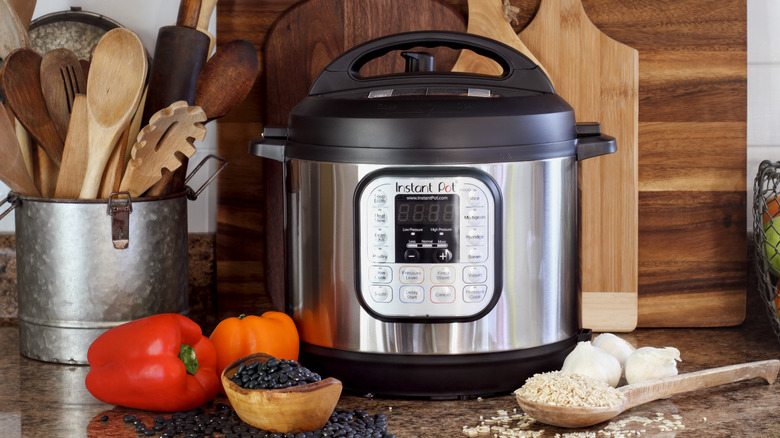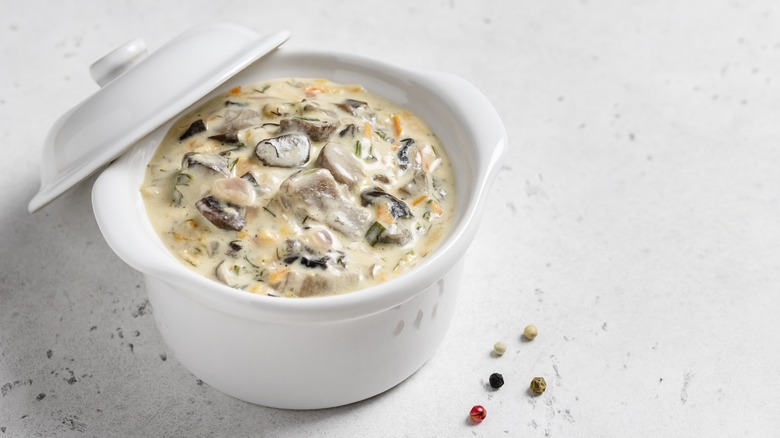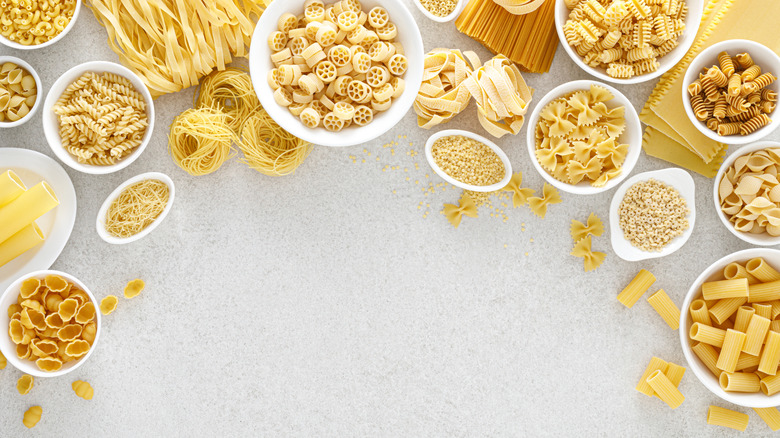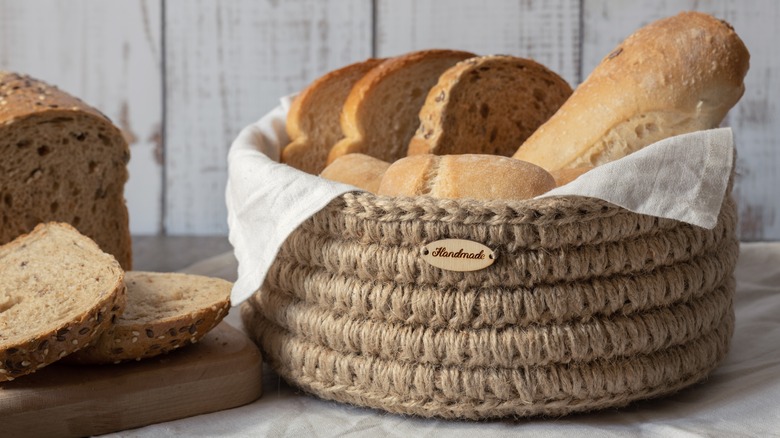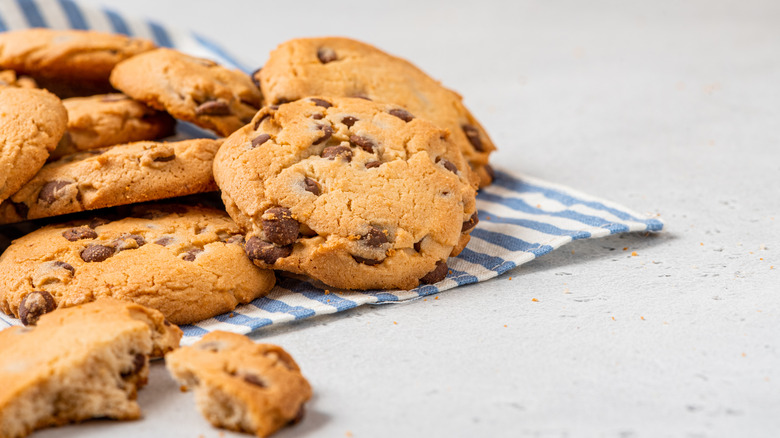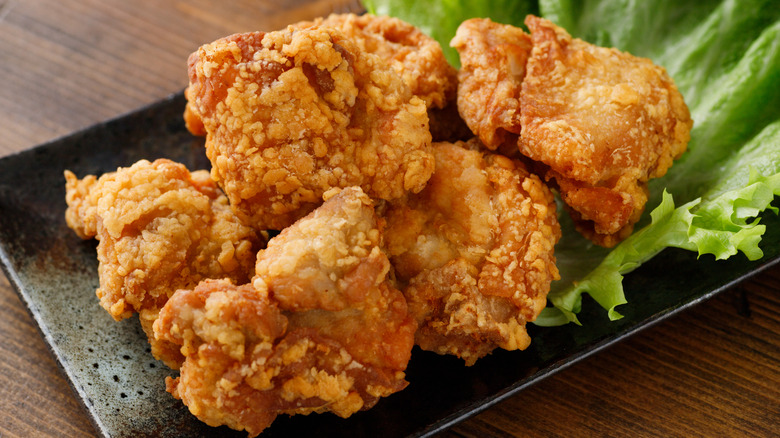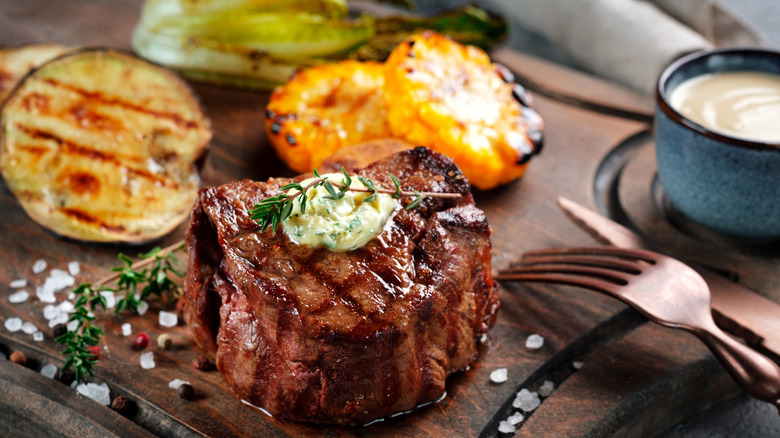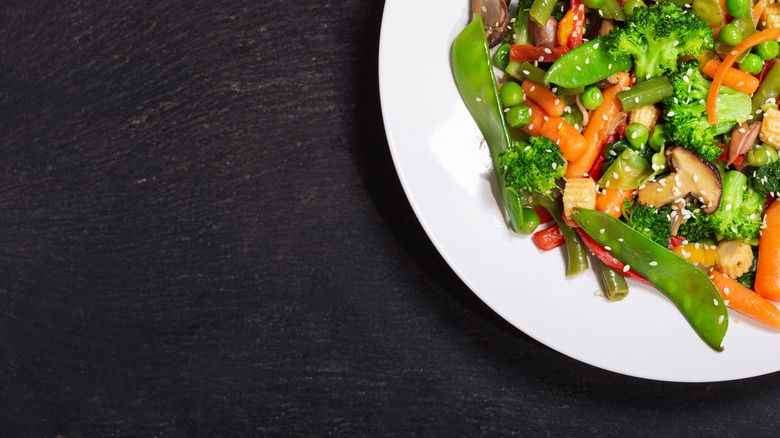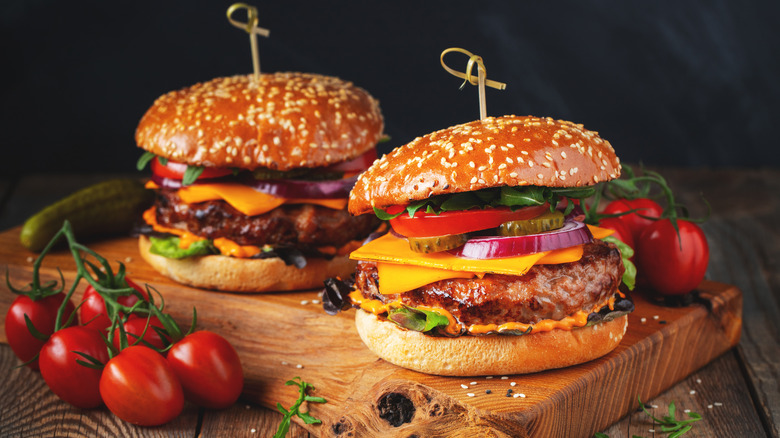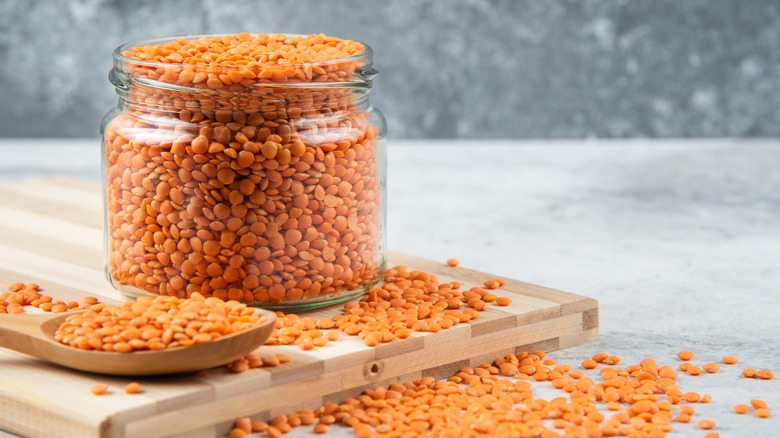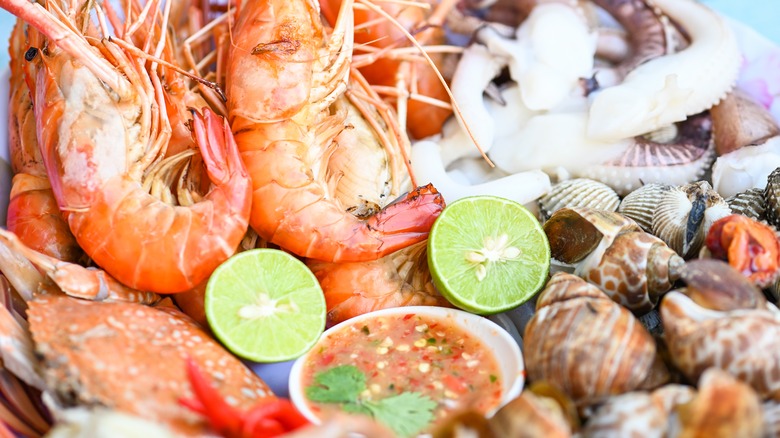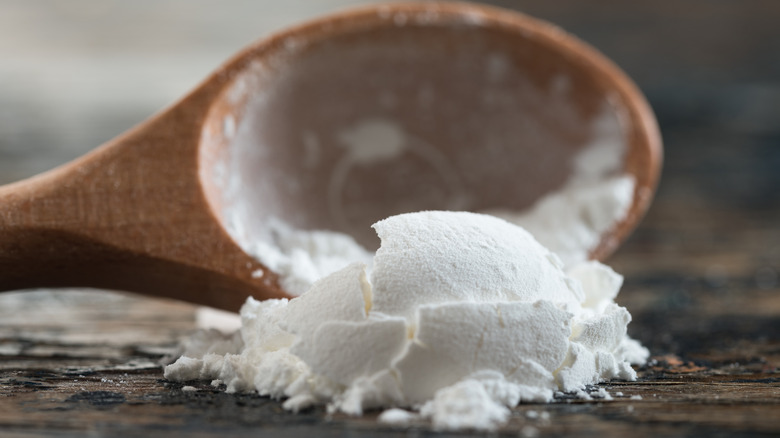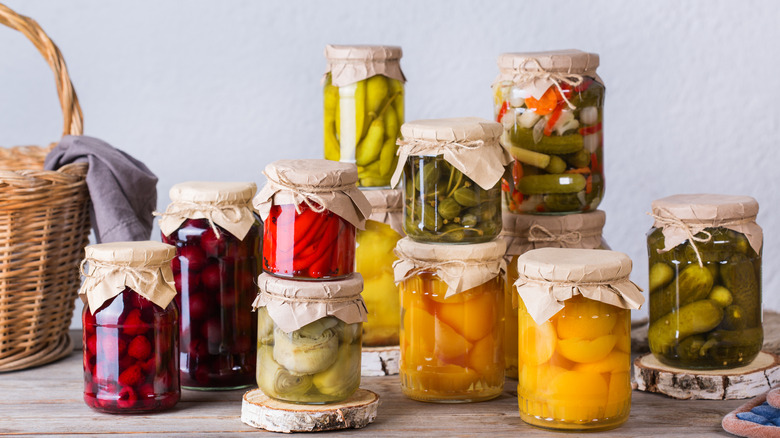12 Things You Should Never Cook In Your Instant Pot
On those tough days after a long commute home, sometimes all you need is to have your dinner cooked for you by a machine while you soak in the tub. This is where the Instant Pot comes in. Over the past few years, the Instant Pot has grown in popularity. According to Cnet, some of the biggest draws of the Instant Pot include its general ease and safety of use, easy cleanup, and the large variety of meals that you can cook with it — some of which are quite elaborate and would ordinarily take hours to cook. Perhaps the biggest draw of all is that the Instant Pot is exceptionally versatile.
While the possibilities are virtually endless when it comes to cooking with your Instant Pot, as with all things, there are some caveats to be aware of. Further, just because you can technically cook certain foods in the Instant Pot doesn't mean it is always the best tool for the job. Whether it's because of safety, changes in texture or taste, nutrient quality, or to simply uphold the integrity of the ingredients, some foods should never be cooked in the Instant Pot. Read on to find out what these foods are and how you should cook them instead.
1. Dairy-based sauces
Whether you're making a sauce as a condiment or want to feature it as the star of your dish, you can almost always rely on the Instant Pot to get the job done. That is, unless you're making a dairy-based sauce. Adding milk or cream to your food will give it a richer flavor and nutrient profile, but as a general rule of thumb, dairy should not be left to cook for long periods of time or at too high a temperature.
According to Simple Lifesaver, when you add dairy to a pressure cooker the quick heat function will bring it to a boil quite fast, which will result in a curdled mess. This is because too much heat too quickly causes the emulsion of fat and water in the dairy to break down. Similarly, slow cooking for long periods of time will also cause cheeses and cream to separate, despite the low heat (via Family Education). The Instant Pot has both pressure cooking and slow cooking functions, and you might be tempted to just cook up your creamy mushroom sauce using them. However, you're better off making this on the stovetop. It will take a few extra minutes of attention, but you don't run the risk of wasting good quality ingredients.
2. Pasta or noodles
Speaking of creamy mushroom sauce, what better pairing for that than pasta? Fine, maybe you prefer a tomato-based pasta sauce. Either way, pasta and noodles often make for tasty quick-cooking dinners. According to the Instant Pot website, spaghetti and macaroni are listed among the foods you should avoid cooking in your appliance because they are prone to foaming and frothing and may clog your machine. In addition, if you've ever left your pasta or noodles on the stovetop for even a minute or two too long, you'll know how easy it is to overcook them. This leaves you with a soft, gummy mush that even a brilliant sauce cannot redeem.
As one Quora user stated, "Theoretically, you can cook pasta covered with water on low pressure with the steam vent open. You're basically boiling it. But then, it's much harder to check on. Instead, just set a pot of boiling water on the stove and then dump the pasta in. It's way easier." So while you're likely to find countless recipes for Instant Pot pastas and noodles, it really is worth the minimal effort it takes to make these the old-fashioned way. You can make plenty of 30-minute pasta recipes without the help of an Instant Pot.
3. Bread
If the scent of freshly baked bread wafting through the air has ever sent your mind reeling with nostalgia, you know the power of breadmaking. An artfully made loaf of bread is the stuff carb dreams are made of. However, as The Guardian asserts, there is a science that holds this magic together. With a history that dates all the way back to Neolithic times, bread is a delicate dance of chemistry at every stage of the process. With all the care that goes into mixing, kneading, folding, and proofing the perfect dough, baking it in the Instant Pot is unfortunately not going to uphold the integrity of your bread.
As one Reddit user found, baking bread in the Instant Pot will produce a mound of baked dough so pathetic that the highest compliment will go a little something like this: "Thank you for allowing me to see exactly what not to do with my Instant Pot." While you may find recipes for Instant Pot bread peppered across the internet, according to Well + Good, a better application for your Instant Pot is using it to proof the dough instead. This is because you can set it to the ideal temperature, allowing the dough to proof at a consistent rate without any variables interfering with the process.
4. Cakes and cookies
Avid bakers will know that cookie and cake creations live and die by their texture. You want a luxurious fluff to your cakes and a delicate crunchy edge with a chewy center in your cookies. The Instant Pot may not be the best way to achieve either of these outcomes. Helen McCue ran the experiments for Techradar so you don't have to. After baking fudgy chocolate, orange olive oil, and carrot cakes, the common denominator across each of the pressure-cooked bakes was density and a lack of rise leading to varying degrees of disappointment. On the other hand, an oatmeal raisin cookie attempt using the air fry function reportedly looked the part, though the texture was that of dry cake with no rise.
Baking is not just about applying heat — the nature of the environment in which the heat is applied matters too. As one Reddit user states, there is a reason why the oven produces superior bakes: "The Instant Pot provides a very moist environment and doesn't let liquid escape, so you'll have very soggy, dense, moist cakes." And if you don't have an oven or really can't be bothered to fire it up, other Reddit users still insist on another alternative for your cakes and cookies: a toaster oven.
5. Deep-fried foods
According to Kitchen Snitches, contrary to what you may assume, pressure cookers are not made to handle deep frying. This is because their usual maximum operating temperature is 250 degrees Fahrenheit, much lower than the typical deep-frying temperature of 350 Fahrenheit. Trying to deep fry foods in a pressure cooker runs a two-fold risk. First, it can damage your pressure cooker, and second, your food may not be cooked through — which is a potential health hazard.
If you, like this Reddit user are still curious about what would happen if you "put an inch of oil at the bottom of the instant pot, add the chicken, seal the lid, and give it a 20-minute pressure cook program," you would do well to heed this response: "Even if you could get to frying temperature (375 or so), this would be a really bad idea. I doubt the IPs gasket was meant to keep in oil at that temperature. Think 'catastrophic gasket failure' with hot oil." Your Instant Pot will not perform the deep-frying magic you need. Perhaps a pressure fryer may come in handy here, and might even have some advantages, including lower costs of oil and faster and more flavorful cooking compared to conventional deep frying.
6. Steaks
Just because you can, doesn't mean you should. This should be your mantra if ever you are tempted to place a cut of steak into your Instant Pot. A good piece of well-made steak will be marked by a number of characteristics: a seared exterior with just the right amount of char, a tender and juicy interior, and above all, loads of flavor. You should never put a steak in your Instant Pot; it will simply turn into a mushy mound of meat, especially as the Instant Pot isn't really equipped to create that beautiful exterior sear.
This isn't to say that the Instant Pot can't be used to make delicious beef; it's just not suited for steaks, which do best with hot, fast, dry cooking methods. Beef dishes that would normally simmer for a long time to tenderize tough cuts, such as this Instant Pot beef Stroganoff recipe, are perfect for cooking in your favorite appliance.
7. Stir-fries
If you're not a pasta or noodle fan, stir-fries are some of the best quick dinners on those weeknights when your energy is utterly sapped. Not only are they tasty and leave plenty of room to customize and build unique flavors — they're also a great way to use up the last of your vegetable odds and ends rather than letting them go bad in the back of your refrigerator. When you're tired though, you may still wonder how to speed up the process using your Instant Pot.
According to this Reddit user, the reason you shouldn't stir-fry in an Instant Pot truly does lie in the name of the dish: "I don't do stir-frying in the instant pot simply because of its name: STIR = FRY. You can't stir in the pot while cooking, and it's best done in a proper pan. You could use your IP to cook noodles to put in there, but the small pieces of veg turn to mush." Additionally, per MasterClass, the first secret to a perfect stir-fry lies in the equipment — a wok. By concentrating the heat in the center of the pan, a wok allows some components to cook quickly while others can be pushed to the sides for lower heat. An Instant Pot does not offer this level of control over your ingredients and may even slow down the process unnecessarily.
8. Burgers
The Instant Pot's versatility is unmatched, but it can't do everything. When it comes to burgers, the Instant Pot once again pales in comparison to other cooking methods, which is why you should never cook burgers in your Instant Pot. You could have perfectly seasoned and formed burger patties, only to ruin them at the final stage.
Like steaks which require a crispy sear, burgers need an external crust. And one way of getting this is by using a cast iron skillet. You could use a nonstick pan, but nonstick pans can release toxic fumes if you cook with them at very high temperatures. Cast iron skillets, on the other hand, are excellent for cooking at high temperatures and far superior at creating that delicious crust you want on your burgers. There's always the good old-fashioned grilling method, but when that's far too much effort, or you don't have a cast iron skillet, you can also use an aluminum or stainless steel frying pan. All will work better than an Instant Pot.
9. Red lentils
Lentils are tasty and versatile and boast an impressive nutrient profile. They can be used as a meat alternative given their protein content and can bulk up salads or add dimensional flavors and textures to various stews and soups. According to BBC Goodfood, the different types of lentils need varying amounts of time to cook. For instance, yellow lentils would ordinarily take about 40 to 45 minutes, green and brown lentils need about 35 to 45 minutes, puy lentils take 25 to 30 minutes, and red lentils are some of the most quick-cooking lentils at 15 to 20 minutes.
While other types of lentils may be great in the Instant Pot, like this Instant Pot lentils and eggs recipe, not all lentils will do well in the Instant Pot. Given how short the cooking time for red lentils is — sometimes even 10 minutes, per Chatelaine — they're better off staying out of the Instant Pot. Otherwise, you run the risk of ending up with a pot of overcooked, mushy lentils. Red lentils do make a yummy puree, but that is only really tasty if it was the intention from the moment you stepped into the kitchen, not a last-ditch effort to save overcooked lentils.
10. Fish and seafood
When it comes to fish, it's important to maintain high levels of care and attention from the moment you purchase it right until you serve it. While you may be tempted to have your Instant Pot do all the work, it's not necessarily the best tool for the job. Fish and other seafood are notoriously easy to overcook, so keeping them away from the Instant Pot is about upholding the integrity of their delicate flavors and textures.
According to City Fish Market, mussels and clams cook for about three to five and five to 10 minutes respectively. Shrimp takes about 60 to 90 seconds. Once overcooked, seafood tends to have a chewy texture. You can avoid this by having a bowl ready beside your pot and using tongs to place the cooked seafood in the bowl as soon as the mussels and clams open or as soon as the shrimp curls into a perfect "C." Of course, you don't have this level of control with an Instant Pot, and if you don't set the timer perfectly, you're liable to open the lid to reveal tough, overcooked seafood. Combine this with how quickly seafood cooks by conventional methods and there's no reason to break out the Instant Pot for this type of ingredient.
11. Thickening agents
A well-placed thickening agent can elevate a dish from drab and runny to thick and dreamy. However, it's important to know what you want the agent to do, and to time it well. While cornstarch may be the first thickening agent to come to mind for most home cooks, according to The Culinary Pro, there are a number of ways that flour can commonly be used as a thickening agent. You can mix it with water to make a whitewash, with equal parts fat or oil to make a roux, or add it in the form of bread crumbs to liquids. Whitewash is not as common in professional kitchens, and while it's easy to mix up when you're out of cornstarch, it does need some time to cook, while roux and bread crumbs are a little more forgiving.
Per One Good Thing, when it comes to the Instant Pot, thickening agents are similar to dairy products. They can take a downhill turn quite quickly and quite drastically. As such, in the same way you would add dairy products only as a finishing touch to your Instant Pot dish, the same should be done with thickening agents. You can even empty your Instant Pot of the food, reserving some of the cooking liquid, add a little cornstarch, and turn it into a sauce using the sauté function.
12. Any foods you're canning
In 2018, Instant Pot launched a model — the Instant Pot Max — that boasted a canning function. Per Cnet, not everyone was celebrating this model's release into the market as concerns rose regarding the safety of this function for home canned goods. If you grew up in a kitchen that was filled with jars of pickles, jams, and various other preserves, you'll know the delicious joys of home canning. However, a key component of this joy has to do with the safety precautions that are taken to ensure canned foods cause no illness when consumed.
The National Center for Home Food Preservation doesn't recommend using electric multi-cookers like the Instant Pot for canning because there hasn't been research into whether electric cookers maintain a safe temperature throughout the canning process. In essence, any supposed ease offered for your home canning by an electric multi-cooker is simply not worth the risk. According to the Centers for Disease Control and Prevention, the best way to ensure your home canning is safe is to ensure that you follow the USDA's Complete Guide to Home Canning.
